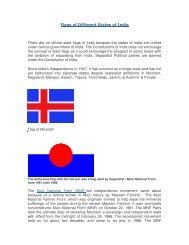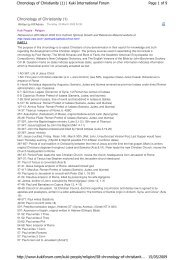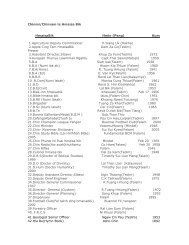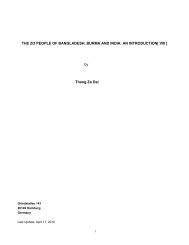The Geology of Burma - Zomi Online Library
The Geology of Burma - Zomi Online Library
The Geology of Burma - Zomi Online Library
You also want an ePaper? Increase the reach of your titles
YUMPU automatically turns print PDFs into web optimized ePapers that Google loves.
Bibliography <strong>of</strong> <strong>Burma</strong>n Earth Science<br />
Economy<br />
<strong>Burma</strong> is one <strong>of</strong> the poorest nations in southeastern Asia, suffering from decades<br />
<strong>of</strong> stagnation, mismanagement and isolation. <strong>Burma</strong>'s GDP grows at an average rate <strong>of</strong><br />
2.9% annually – the lowest rate <strong>of</strong> economic growth in the Greater Mekong Sub-region.<br />
Agriculture, forestry, and fishing together constitute the largest contributor to<br />
<strong>Burma</strong>’s economy. About half <strong>of</strong> all agricultural land in <strong>Burma</strong> is devoted to rice, and to<br />
increase production the government has promoted multiple cropping (sequential<br />
cultivation <strong>of</strong> two or more crops on a single piece <strong>of</strong> land in a single year), a system that<br />
is easily supported by the country’s climate. As a whole, the sector accounts for nearly<br />
one-half <strong>of</strong> the country’s gross domestic product and employs about two-thirds <strong>of</strong> the<br />
labor force.<br />
<strong>The</strong> second most important element in the diet, after rice, is fish, either fresh fish<br />
or in the form <strong>of</strong> ngapi, a sort <strong>of</strong> nutritional paste that is prepared in a variety <strong>of</strong> ways and<br />
eaten as a condiment. Marine fisheries are not well developed, although the industry’s<br />
reported commercial catch is much greater than that reported from inland waters. Much<br />
private, noncommercial fishing is provided, however, in virtually every type <strong>of</strong><br />
permanent, seasonal, or artificial body <strong>of</strong> inland water <strong>of</strong> any size. Non-indigenous fish,<br />
including the European carp and the tilapia, originally brought from Thailand, have<br />
become the focus <strong>of</strong> a growing aquaculture industry.<br />
Under British administration and until the early 1960s, <strong>Burma</strong> was the wealthiest<br />
country in Southeast Asia. It was once the world's largest exporter <strong>of</strong> rice. After <strong>Burma</strong><br />
was <strong>of</strong>ficially annexed to British India in 1886, however, colonial policy called for a<br />
more commercially oriented and more extensive cultivation <strong>of</strong> rice. Since the indigenous<br />
labor force was thought to be insufficient to support the colonial export economy, the<br />
immigration <strong>of</strong> Indian and Chinese laborers into <strong>Burma</strong> was <strong>of</strong>ficially encouraged during<br />
the early decades <strong>of</strong> the 20th century. Despite the departure <strong>of</strong> much <strong>of</strong> the immigrant<br />
labor force and the relatively low growth in rice production after World War II, rice<br />
remained both the basic food and, until the 1990s (when it was overtaken by dry beans),<br />
the principal agricultural export <strong>of</strong> <strong>Burma</strong>.<br />
Also during the British administration, <strong>Burma</strong> supplied oil through the <strong>Burma</strong>h<br />
Oil Company. <strong>Burma</strong> also had a wealth <strong>of</strong> natural and labor resources. It produced 75%<br />
<strong>of</strong> the world's teak and had a highly literate population. <strong>The</strong> country was believed to be<br />
on the fast track to development.<br />
After a parliamentary government was formed in 1948, Prime Minister U Nu<br />
attempted to make <strong>Burma</strong> a welfare state. His administration adopted the Two-Year<br />
Economic Development Plan, which was a failure. <strong>The</strong> 1962 coup d’état was followed by<br />
an economic scheme called the “Burmese Way to Socialism”, a plan to nationalize all<br />
industries, with the exception <strong>of</strong> agriculture. In 1989, the Burmese government began<br />
decentralizing economic control. It has since liberalized certain sectors <strong>of</strong> the economy,<br />
although lucrative industries <strong>of</strong> gems, oil and forestry remain heavily regulated. <strong>The</strong>se<br />
industries have recently been exploited by foreign corporations and governments which<br />
have partnered with the local government to gain access to <strong>Burma</strong>'s natural resources.<br />
<strong>The</strong> major occupations in <strong>Burma</strong> are in agricultural processing; wood and wood<br />
products; copper, tin, tungsten, iron; cement, construction materials; pharmaceuticals;<br />
fertilizer; natural gas; garments, jade and gems. <strong>The</strong> labor force in 2001 was 70% in<br />
agriculture; 7% in industry and 23% in services.<br />
September 2008 22







